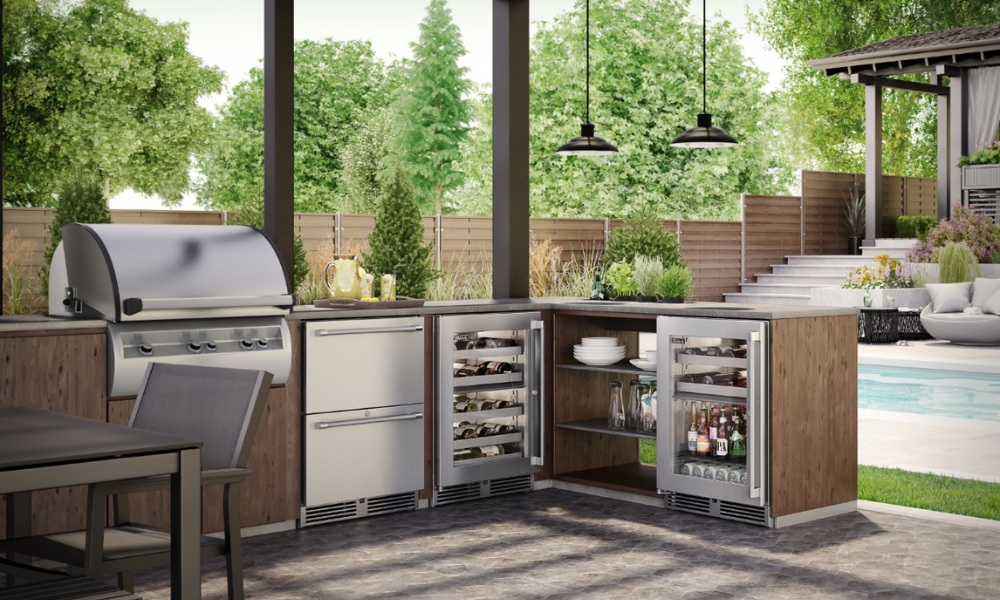Designing an outdoor kitchen is an exciting opportunity to combine practicality and aesthetics for your open-air cooking space. But one of the first and most important decisions you’ll make is choosing the right material. With so many options available, the question remains: solid wood, plywood, or stainless steel—what’s the best option for your modern outdoor kitchen?
Each material brings its own set of strengths and weaknesses to the table. However, if you’re after a modern, durable, and low-maintenance solution, stainless steel is likely to stand out. In this article, we’ll explore the pros and cons of solid wood, plywood, and stainless steel, with a particular emphasis on why stainless steel might be the perfect fit for your outdoor cooking space.
Key Areas to Compare
Before diving into the details, it’s essential to understand the main factors you should consider when selecting a material:
Durability – Can the material handle exposure to the elements?
Maintenance – How easy is it to keep the material clean and functional?
Appearance – Does it complement your outdoor aesthetic?
Cost – Does it fit your budget without compromising on quality?
Solid Wood Outdoor Kitchens
Solid wood is a go-to choice for homeowners who love the warm, organic aesthetic of natural materials. While wood looks stunning in many settings, it comes with significant challenges in an outdoor environment.
Pros
Aesthetic Appeal: Solid wood creates a cozy, rustic ambiance that blends beautifully with natural surroundings. Woods like teak or cedar can add character to your outdoor kitchen.
Customizable: It can be stained or painted to suit various design styles.
Cons
Vulnerability to Weather: Wood is highly susceptible to warping, cracking, and rotting when exposed to moisture, heat, and sunlight. Even weather-resistant woods require significant maintenance.
High Maintenance: Requires regular sealing, staining, or painting to preserve its appearance and structural integrity.
Cost: Premium hardwoods are expensive, and frequent maintenance adds to long-term costs.
Solid wood shines in terms of looks and charm but often doesn’t hold up well against outdoor challenges, making it more suitable for covered or partially enclosed spaces.
Plywood Outdoor Kitchens
Plywood is a budget-friendly alternative to solid wood, and with the right treatment, it can be used in outdoor settings. However, it’s not without its drawbacks.
Pros
Affordability: Plywood is significantly cheaper than solid wood, making it a popular choice for cost-conscious homeowners.
Lightweight: Easier to install and work with, saving time and labor during construction.
Specialty Options: Marine-grade plywood is designed to resist moisture better than standard plywood.
Cons
Durability Issues: Even marine-grade plywood is prone to delamination, warping, and decay over time, especially in high-moisture environments.
Aesthetic Limitations: While laminates or veneers can give plywood a finished look, it doesn’t compare to the premium feel of real wood or stainless steel.
Ongoing Maintenance: Plywood must be adequately sealed and protected to prevent damage, and even with regular upkeep, its lifespan is limited.
Plywood can work for budget-conscious projects but struggles to deliver the longevity and resilience that outdoor kitchens demand.
Stainless Steel Outdoor Kitchens
When it comes to outdoor kitchen materials, stainless steel is the gold standard—and for good reason. It’s an all-around winner in terms of durability, low maintenance, and modern aesthetics. Let’s dive into why stainless steel is often the top choice for outdoor kitchens.
Pros
- Durability
Stainless steel is virtually indestructible when it comes to outdoor use:
Weather-Resistance: Unlike wood or plywood, stainless steel won’t warp, rot, or crack when exposed to moisture, heat, or sunlight.
Corrosion-Resistance: High-quality stainless steel, such as 304-grade or the more corrosion-resistant 316-grade, won’t rust even in humid or coastal environments.
Heat-Resilience: Perfect for areas near grills or cooktops as it doesn’t degrade under high temperatures.
- Low Maintenance
Stainless steel’s non-porous surface makes cleaning and maintenance effortless:
A simple wipe with mild soap and water keeps it looking new.
It doesn’t require regular sealing, staining, or specialized treatments like wood or plywood.
- Modern Style
If you’re after a sleek, contemporary look, stainless steel delivers unmatched sophistication.
Its neutral metallic tone pairs well with materials like stone, tile, or concrete in countertops and backsplashes.
- Hygiene
Stainless steel is non-porous and doesn’t absorb bacteria, making it the most sanitary option for food prep surfaces.
- Longevity
While stainless steel may have a higher upfront cost, its durability and minimal upkeep make it a long-term investment that pays off over time.
Cons
While stainless steel is a standout option, it’s not without a few limitations:
Initial Expense: Stainless steel is more expensive than plywood and may cost more than some types of wood. However, its long lifespan offsets the upfront expense.
Heat Absorption: In areas exposed to direct sunlight, stainless steel can get hot to the touch. Strategic positioning or shading can help mitigate this issue.
Fingerprints and Scratches: Stainless steel can show smudges and scratches, but regular cleaning and optional protective coatings can address these concerns.
Even with these minor drawbacks, stainless steel’s advantages far outweigh its limitations, making it the premier choice for outdoor kitchens.
Whether you’re designing a cozy backyard retreat or a fully equipped culinary station, the material you choose for your outdoor kitchen will set the tone for its usability and longevity. While solid wood and plywood may have their merits, stainless steel is the ultimate choice for homeowners who want a material that combines modern style with exceptional performance in outdoor environments.

